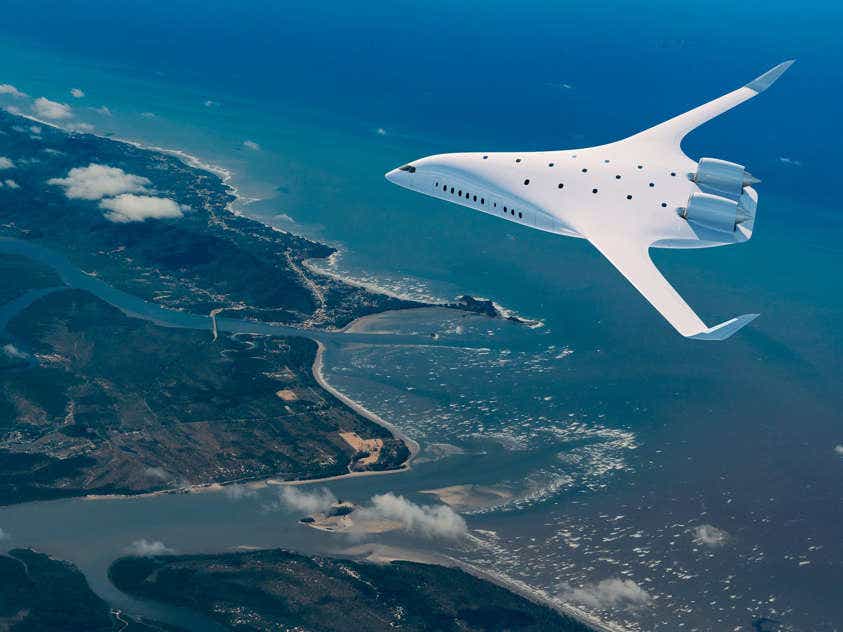Radical new all-in-one wing airplane concept could be the future of flight
A new kind of airplane looks nothing like today’s commercial jets—and it could change everything from passenger comfort to military power.

The Z4’s radical shape could cut fuel use by half while reinventing how people fly. (CREDIT: JetZero)
A new kind of airplane is taking shape in Southern California. Its design looks nothing like today’s commercial jets—and it could change everything from passenger comfort to military power.
Aircraft manufacturers are in a race. They want to build more efficient jets as airlines search for ways to cut fuel use and lower costs. Instead of the old tube-and-wing structure, a new shape is leading the charge: the blended-wing body.
This sleek design merges the fuselage and wings into one continuous surface. The result? Less drag, more lift, and huge potential savings. Both civilian and military buyers are paying attention.
A radical new design with massive potential
Blended-wing aircraft aren't completely new. The U.S. Air Force has used the concept in some planes for years. According to the Air Force, blending the body and wings can reduce drag by up to 30%. That means less fuel, longer flights, and better economics.
The startup JetZero is betting big on this concept. So is the Air Force, which gave the company a $235 million contract to build a full-scale demonstrator by 2027. United Airlines, Delta, and Alaska Airlines are also onboard as investors and development partners.
JetZero’s futuristic Z4 jet could hold up to 250 passengers. That’s the same range as a Boeing 767, but with only half the fuel burn. And the Z4 isn’t just more efficient—it’s different inside and out.
Related Stories
The design eliminates the long, narrow fuselage seen in typical jets. Instead, the wide, flat body opens up new possibilities for layout. United Airlines’ managing director Andrew Chang called it a “living room in the sky.”
"Everything around the customer travel experience — how they sit in the plane, board, and deplane, and how [crewmembers] serve them — can be reinvented around the new space within this new aircraft design," Chang said.
Rows could be shorter, and more aisles could make it easier to board and exit. Up to four entry doors may speed up that process even more. Wider cabins could offer new spaces like lounges, kids' play areas, or upgraded seating zones. Every inch could hold revenue-generating passengers, United said.
JetZero’s approach gives airlines the chance to rethink how passengers travel. In addition to standard and premium seating, Starlink WiFi and entertainment upgrades are in the works.
Military muscle from a civilian startup
While airlines are excited about comfort and savings, the Air Force is watching for something else: reach, fuel, and payload. JetZero’s Z4 has caught military planners’ eyes not just for what it carries, but how far it can go.
The aircraft could fly over 5,700 miles nonstop while using traditional or sustainable aviation fuel. That kind of range opens new opportunities, especially in the Indo-Pacific region where vast distances matter.
For retired Air Force pilot Brian Tighe, the Z4 represents a huge leap forward. "The capability that the Z4 brings, for the tanker mission specifically, is a quantum leap," said Tighe, who now serves as executive vice president of Allied Defense Services International.
JetZero plans a tanker version, the KC-Z4, with a fuel load similar to the KC-135 and KC-46, around 200,000 pounds. But the Z4 would use that fuel more efficiently, reaching farther into contested airspace while carrying up to 120 troops or 21 cargo pallets.
Thanks to its blended wing, the Z4 can also use shorter runways and carry taller cargo than current tankers. Airlift variants are in development too, with a rear cargo ramp and roomier designs tailored to carry bulky gear.
According to JetZero executive Nate Metzler, the KC-Z4 could offload enough fuel after a 4,000-nautical-mile flight to refuel six F-35 fighters, all while returning to base without stopping. In contrast, the KC-46 can refuel just one.
"You could sit in a refueling track for 45 minutes as the F-35s fill up and go on to do their work," Metzler said.
Filling a critical gap in U.S. military logistics
The Air Force’s main refueling jet, the KC-135, is now over 60 years old. Gen. Randall Reed, head of U.S. Transportation Command, warned Congress that the aging fleet poses a growing risk. “The air refueling fleet is the most stressed deployment, sustainment, and combat capability,” he wrote.
While the KC-46 offers some relief, it has been plagued with technical setbacks. And the Air Force doesn’t plan to buy enough of them to replace the KC-135 entirely. That leaves a gap.
The KC-Z4 could step in. Its efficiency, flexibility, and large cargo hold make it attractive for both tanker and transport missions. Retired Maj. Gen. Erich Novak called it a game changer. “Energy efficiency, payload, range—those are the brass rings for tanker aircraft,” he said.
Former pilots are helping JetZero fine-tune every detail. The company designed a new cockpit layout using synchronized active sidesticks, combining the best of Airbus and Boeing’s approaches. Retired Maj. Gen. Dan Heires said that helps pilots know what their copilot is doing—a big improvement.
JetZero also studied the problems faced by KC-46 boom operators. Many reported eye strain and fatigue from distorted visuals in the remote vision system. JetZero used their feedback to build a more ergonomic and accurate control station.
“We want to have more natural movements so as not to fatigue the small muscles in the wrists and arm,” Metzler said.
From prototype to production: A long road ahead
Despite all the promise, JetZero still faces serious hurdles. The Z4 hasn't flown at full scale yet. Only a smaller prototype completed its first flight in 2024. The demonstrator jet is due in 2027, and commercial certification would come after that.
CEO Tom O’Leary said production will require a massive facility—up to 1,000 acres—to handle the carbon fiber components that make up most of the aircraft. Scaled Composites, a Northrop Grumman subsidiary, is building the demonstrator, but JetZero will need a long-term manufacturing partner.
To speed things up, the company is looking at private investment and possibly government loans. While early funding from the Air Force helped, analysts warn the current political environment could shift priorities.
Even the choice of engines raises questions. The demonstrator will use the aging PW2000, which also powers the C-17, but that engine lags behind modern jet technology. Certification, evacuation rules, and other civilian standards could complicate the process further.
Still, market interest remains high. Natilus and Airbus are exploring similar designs. Airbus has its ZEROe concept for hydrogen-powered flight. Natilus, meanwhile, is working on the 200-seat Horizon jet with ideas for onboard lounges and play areas.
JetZero’s Z4, however, is the furthest along in combining serious airline support, government investment, and concrete milestones.
“This is the game-changer,” said Novak. “This is a different way to reinvent aviation.”
Note: The article above provided above by The Brighter Side of News.
Like these kind of feel good stories? Get The Brighter Side of News' newsletter.



